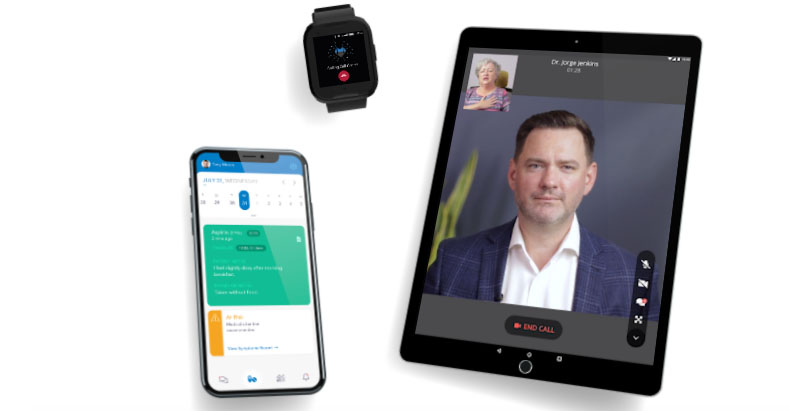The Life Sciences Report: You're vice president and an analyst for special situations in healthcare. What is a special situation?
Russell Stanley: Canada has traditionally been a resource-focused market, so many Canadian brokerages define special situations as anything that is non-resource. I focus on small companies, with market caps of between $50 million ($50M) and $500M. In my coverage, we look for a handful of key attributes—strong industry drivers, strong management teams and attractive growth profiles. Within that, we try to identify names that are underfollowed by the brokerage community.
A little more than a year ago, we identified the U.S. healthcare space as being a good opportunity, and there are several Toronto Stock Exchange (TSX) or TSX Venture-listed names that we chose to focus on. Canada-listed companies with their primary operations in the U.S. have very little analyst coverage, and so we believe we have found an opportunity to bring new ideas to our investors.
TLSR: Why aren't companies doing business in the U.S. domiciled in the U.S.? It might be easier for them to get analyst coverage and U.S. investor sponsorship that way, and they could still have the Canadian coverage. Is there a specific reason?
RS: There are a couple of things. Size is probably the primary determinant. A company with a $100M market cap that's listed on the TSX is a small-cap company. Until relatively recently, a name of that size would be more or less forgotten in the U.S. It's just too small to move the needle. But in a few cases, some of these companies have actually been around for a while.
"Nobilis Health Corp. gives investors access to a market that's otherwise predominately privately held."
I'd use the example of Nobilis Health Corp. (HLTH:NYSE; NHC:TSX). It completed its original public transaction back in the days of the old income trust structure on the TSX, which goes back to late 2006. It is a function of size; that's the primary distinction.
TLSR: Your coverage seems to include companies that are acquisitive. Is that fair to say, generally speaking?
RS: Yes. Some of the acquisitiveness is because the companies have access to capital, and they operate in industries otherwise dominated by private companies too small to be public. Those smaller companies, therefore, don't have the same access to the equity market, or even access to limited additional debt.
I use the example of, again, Nobilis. Since the vast majority of ambulatory surgical centers in the U.S. are owned by physicians or physician groups, Nobilis is one of a handful of public company structures that gives investors access to a market that's otherwise predominately privately held. There is an opportunity for public companies to access markets and fund acquisitions of private companies with lower multiples.
TLSR: In small-cap biotech, acquisitions are about molecular biology, targets, intellectual property and disease indications. In many cases, you don't have to acquire people when you acquire a biotech company. But in acquiring standalone clinics, or physician practice management groups, you have to integrate not just business models, but also people. Is there a special set of risks in acquiring diverse personalities?
RS: Absolutely. In a number of cases, businesses have been founded by entrepreneurs who want to do their own thing, so to speak, and integration after the transaction is always a key point of risk. Mitigating that risk comes from how the purchase price is structured. We look for purchase structures that involve some sort of earn-out to make sure the vendors have a target and their interests are aligned with the company's over a longer period of time, say three years. We also want to see employment agreements, ideally with the founders, that extend three to five years so that we know they're staying with the business. The primary asset is the management team and the personnel being brought over. We look for the purchase structure and prior success on integration to help mitigate the risk and provide continuity.
TLSR: The binding element is that the people being acquired normally get equity for selling their assets to an acquirer, isn't it?
RS: That's right—it's either equity and/or an earn-out where the seller gets future compensation if certain targets are met. Even if the earn-out is in cash, it's based on performance over a three-year period so that the sellers and the people you're bringing over are incentivized to manage the business in a way that's consistent with the overall company's objectives.
TLSR: Management teams must do extraordinary due diligence before acquiring a physician practice management group or clinic, but I'm sure part of your own diligence process is looking at the track record of the acquirer's management. Is that how you decide whether you like a company?
RS: We spend as much time with management as possible. These are important attributes but, unfortunately, they are very difficult to quantify. You want to look into management's eyes, and try to ascertain if the team has the right objectives and whether or not it can execute.
"There is an opportunity for public companies to access markets and fund acquisitions of private companies with lower multiples."
One of the key attributes we look for is ownership in the company. You want managers to own a meaningful share of the capital structure of the company. You look for a healthy percentage owned by insiders—the management team and the board—so you know their interests are broadly aligned with those of the public investors.
Management teams are people, too. They make mistakes. But as long as they're pointed in the same direction and they're competent, then the odds of success are favorable. But when insiders don't own a significant portion of the company, it can be far more difficult to believe they'll manage it in a way that benefits investors.
TLSR: You use EBITDA (earnings before interest, taxes, depreciation and amortization) as a metric in your evaluation of these companies. Why not the bottom line? Why not the top line?
RS: At the end of the day, EBITDA is singularly best at capturing operating performance. If you just look at the top line, you're not getting a sense as to how profitable the operations are. If you just look at the bottom line—at accrual earnings—there are a number of accounting differences that might impact the way earnings are shown that don't have any relevance to the operating performance of the company. EBITDA is probably the best way to capture how strongly the company is performing within its industry, and it's reported on a reasonably consistent basis. Even though EBITDA calculations can vary, there is usually enough disclosure to account for those variations.
A final note on EBITDA: While a number of the companies we cover are acquisitive, we also believe at some point they become attractive acquisition targets themselves, and EBITDA is the primary number used in valuing an operating company from a merger-and-acquisition (M&A) perspective. Looking at a company's EBITDA performance gives us some idea as to how the company is going to be viewed by a would-be acquirer.
TLSR: You have mentioned Nobilis several times. You obviously like the company. Would you go ahead and speak to that, please?
RS: Last spring, Nobilis listed on the New York market (NYSE.MKT) exchange, under HLTH, a very apt ticker. It's Canada-listed, but its operations are in the U.S. It owns and operates hospitals and ambulatory surgical centers (ASCs), primarily in Texas and Arizona. These facilities provide elective surgical procedures with a clinical focus on higher-reimbursement types like pain management, bariatric and spine procedures. The vast majority of the payer base comes from private insurance.
"We look for the purchase structure and prior success on integration to help mitigate the risk of acquisition and provide continuity."
There are several larger, more well-known names listed on either NASDAQ or the NYSE that cover the surgical hospital space, but Nobilis is somewhat unique for its clinical focus on the higher-reimbursement case types and the private payer network, which I think speaks to being able to maintain margins in an industry that's otherwise seeing a lot of cost pressure. We like the name.
TLSR: I see the stock has been under pressure, but it has gained some significant strength over the past four weeks. Was there something that caught investors' eyes? Was it oversold?
RS: Yes, I think it was oversold. Back in mid-October a very negative report was posted on Seeking Alpha. It was anonymously written, and we presume it was authored by a hedge fund. That put the stock under a lot of pressure. The company has also been a little delayed in filing its Q3/15 numbers. We expect those to be out any day at this point, and that should be a catalyst for the stock because it should derisk the story.
TLSR: Is Nobilis benefitting from public and private payers alike wanting patients to get more surgical care on an outpatient basis?
RS: Several of the company's facilities are ambulatory surgical centers (ASCs), and usually the cost of a procedure in that kind of setting is 55–65% of the cost in a traditional general hospital. There are a number of reasons for that, including the fact that these facilities can focus on specific procedures, and don't have to take emergency care or uninsured patients. The procedures can be scheduled, and you have the benefits of specialized personnel. All of these things allow ASCs to be reimbursed at a lower rate than a traditional hospital. That's something that the company has benefitted from.
TLSR: Speaking of large hospitals, they are buying up physician practice management groups, and some are building their own standalone clinics for colonoscopies and other procedures that can be done in high volume and on a scheduled basis. How much competitive pressure is that on Nobilis?
RS: It's something the company has had to contend with for a number of years now. More recently, we've seen traditional hospitals take an if-you-can't-beat-'em-buy-them approach to ASCs in general. A number have established smaller facilities on their campuses or close by, and that has driven some of the acquisition behavior we've seen. Perhaps the best validation of the opportunity in ASCs is Tenet Healthcare Corp. (THC:NYSE), which made a major acquisition of an ASC operator earlier this year.
"Look for companies where a healthy percentage is owned by insiders so you know their interests are aligned with those of public investors."
We're seeing hospitals concede there is room in the industry for ASCs. With regard to Nobilis, there's definitely competition there, but at the same time, I think the competition creates a more vigorous market and opens up additional opportunities for Nobilis to be acquired by a hospital looking to add additional ASC capability.
TLSR: Another weakness in this model is that there are no economies of scale. Am I reading this wrong?
RS: No, I don't think you are. These ASC units are quite distinct, quite separate, and generally speaking, they need to be self-sufficient. There are some economies of scale, perhaps, from centralized procurement, but the real scale comes from operating each individual facility at optimal capacity levels.
Nobilis is actually very good at that. It acquired a small hospital a bit more than a year ago. It paid about US$7.5M for a 51% stake, and just by improving its patient flow, the facility is now expected to generate $8–12M in EBITDA net to Nobilis this year. The company effectively paid less than 1x EBITDA on a post-transaction basis, and that is all about volumes and scale economies at the facility level. But the facility still requires a certain amount of overhead and a certain amount of spend on marketing to make it all work.
TLSR: From all that you've said about Nobilis, I'm thinking investors really have to put their faith in management as part of the growth theory. Don't you?
RS: You do. The company has made several acquisitions this year as part of its growth strategy, but Nobilis has been very selective in what it's acquired. It has acquired underperforming hospitals, and through marketing it is driving improved patient volumes through those facilities. This is about management capability.
TLSR: Could you go to another name, please?
RS: Convalo Health International Corp. (CXV:TSX.V) operates substance abuse rehabilitation facilities in the U.S. At this point, it basically has one vertically integrated pod in place, in Hollywood. Its operations include detoxification, inpatient rehab, and outpatient rehab. There is an ideal natural progression of a patient through those facilities. We visited the outpatient facility in Hollywood last spring, and it was very busy. The company shortly thereafter acquired a detox and inpatient capability. It plans to open a second outpatient facility in West Los Angeles, and I believe it is planning San Francisco as the third market for entry.
"EBITDA is singularly best at capturing operating performance."
It's a growing space. Substance abuse is, unfortunately, a major problem. To date, the single largest impediment for people who want to seek treatment has been affordability. Of course, the Affordable Care Act, in combination with the Mental Health Parity and Addiction Equity Act of 2008, has really helped to expand coverage requirements and enable people to seek care who otherwise could not afford it. We like the space, and we like the growth strategy Convalo has in place. There are very few investable options for people who want to get into this market. There is only one other substance abuse pure play.
TLSR: You said the company has a single pod currently. It must have a lot of cash on its balance sheet to have a CA$62M market cap. This sounds like a huge valuation for a single-clinic company.
RS: Yes. The next set of financials should reflect a full quarter contribution from the Hollywood pod, but recently the company reported that its revenue run rate (annualized revenue) has approached $30M. Convalo has a very strong balance sheet, with no debt, and cash of just under $25M as of the last balance sheet. The capex required to establish a new pod is relatively small—about $1.5–2M as far as the cash upfront investment. The company's balance sheet is more than ample to fund its plans over the next few years.
TLSR: Aside from that low capex, another positive for this company could be the fact that it's not a clinic treating acute care patients but is more like a mental health facility. Am I reading that right?
RS: That's an accurate assessment. It certainly describes the outpatient facility we saw. It's not an equipment-heavy operation. It is designed primarily as a serene place for patients to be comfortable and find rest—ultimately to help themselves heal from their addiction.
The bear case is that the barrier to entry is relatively low, with that relatively modest capex number and the fact that there isn't a lot of hard science or technology as far as this type of facility is concerned. I think Convalo is a story about speed to market and choosing the right markets to locate facilities in. Part of that is making sure it has a very strong referral network in place from local health practitioners to help drive patients to the facilities.
TLSR: I'm thinking that with these low barriers to entry, and California being a state that doesn't require a certificate of need for substance abuse facilities, there must be some skepticism directed toward companies like Convalo. I wonder if regulators might be concerned that these low-tech operations are in business just to leverage reimbursement that's available. Can you comment on that?
RS: I think you're probably right. That's part of why we conduct site visits, to ensure that investors' money is going to good use. Certainly, a strong sense of skepticism is a healthy attribute among investors. When we completed our site visit last spring, and without intruding on anyone's privacy, we definitely saw and understood that the facility was quite busy with patients and professionals. That was clear.
I think the bigger concern of late around this space relates more to one of the other public companies in the category. I'm talking about AAC Holdings Inc. (AAC:NYSE), the owner of American Addiction Centers. There was a lot of concern around the death of a patient in one of its facilities about five years ago. Recently, some indictments were handed down by the state around several individuals connected with the company at that time. Even as that has yet to play out, and despite all the noise around the stock, AAC still gets a 10x multiple on next year's EBITDA. That's a reflection of investor confidence in the demand for substance abuse treatment, and the fact that there are relatively few pure players that investors can access in the market.
TLSR: Convalo now has a single pod currently in Hollywood, with the next in West Los Angeles. Basically that's across town. But San Francisco is about 400 miles north of L.A. Is that going to be the company's first real test of whether it can go out and duplicate its process and model?
RS: It absolutely is. This story has the benefit of being able to grow organically if management can execute per its plan.
Certainly, moving into a different market is a major challenge. With the company's acquisition of the detox facility and the inpatient facility back in June, it also acquired people who have been in the industry for quite some time, and are reasonably well networked in the San Francisco market. That is part of why the company has identified San Francisco as an attractive market. Convalo believes it already has people to help it round out the referral network needed to drive this business. There is risk, but I think it's manageable.
The best evidence we have of the company's ability to grow organically is the fact that its existing outpatient facility in Hollywood was only opened a bit more than a year ago, and within seven or eight months was operating fairly close to effective capacity. Convalo now has experience going from zero to near capacity in a relatively short period of time, and so I think our growth expectations are reasonable. Certainly, people are the single biggest challenge in expanding the business, but I think Convalo acquired some solid networks with its transactions this past summer.
TLSR: Could you go to another name, please?
RS: Patient Home Monitoring Corp. (PHM:TSX.V) provides in-home monitoring and disease management services to patients primarily in the eastern U.S. With a recent acquisition, it has added operations in the Midwest, and over time, you'll see the company expand its presence geographically.
At this point, Patient Home Monitoring's core services are noninvasive ventilation and durable medical equipment. The company has grown well both organically and by acquisition. It is on a September fiscal year-end, so its next set of financial statements will be due in January. We're looking for solid improvement in revenue in the quarter.
The company has completed a number of acquisitions. Current management includes CEO Casey Hoyt. He came over from a company called Sleep Management, which he founded and expanded, and which was acquired by Patient Home Monitoring back in June. Current management is basically the team that came over from an acquired company this past summer.
TLSR: What is the growth driver?
RS: The company is focused on services and products for older patients who are suffering from chronic disease—heart disease, stroke or diabetes—and, therefore, need constant in-home monitoring and care. Many sufferers have comorbidities, which is unfortunate.
Ultimately, this company's products and services are based on serving an aging population that is living longer but choosing to be managed at home. That, again, ties back to the cost pressures the system faces in trying to limit hospital readmissions and shorten stays.
TLSR: The key here is that reimbursement must be available for all these products. About how much comes from public versus private?
RS: Roughly, half of its revenue is now from Medicare reimbursement; the other half from private insurance. That's down a little bit from a year ago.
One way or another, I think there is a growing understanding out there that, to the extent possible, if you can limit how long people stay in hospitals, and if you can limit readmissions, then you're taking cost out of the system. I think that's why you are seeing support for reimbursement for a lot of these products and services. It's an investment that reduces cost in other areas of the healthcare market.
TLSR: Thank you very much, Russell.
Russell Stanley, vice president at Mackie Research Capital, is a special situations analyst whose primary focuses are industrial products and energy services. Prior to joining Mackie Research Capital in December 2014, Stanley was a special situations analyst at Jennings Capital Inc. Stanley has 18 years of experience in the brokerage industry, including 11 years in equity research. He received his master's degree in business administration (Finance and Strategy) from the Schulich School of Business, York University, and is a CFA charterholder.
Read what other experts are saying about:
Want to read more Life Sciences Report interviews like this? Sign up for our free e-newsletter, and you'll learn when new articles have been published. To see recent interviews with industry analysts and commentators, visit our Streetwise Interviews page.
DISCLOSURE:
1) Dr. George S. Mack conducted this interview for Streetwise Reports LLC, publisher of The Gold Report, The Energy Report and The Life Sciences Report, and provides services to Streetwise Reports as an independent contractor. He owns, or his family owns, shares of the following companies mentioned in this interview: None.
2) The following companies mentioned in the interview are sponsors of Streetwise Reports: Nobilis Health Corp. The companies mentioned in this interview were not involved in any aspect of the interview preparation or post-interview editing so the expert could speak independently about the sector. Streetwise Reports does not accept stock in exchange for its services.
3) Russell Stanley: I own, or my family owns, shares of the following companies mentioned in this interview: None. I personally am, or my family is, paid by the following companies mentioned in this interview: None. Mackie Research Capital Corp. has provided investment banking services for Convalo Health International Corp., Nobilis Health Corp. and Patient Home Monitoring Corp. during the past 12 months. I was not paid by Streetwise Reports for participating in this interview. Comments and opinions expressed are my own comments and opinions. I determined and had final say over which companies would be included in the interview based on my research, understanding of the sector and interview theme. I had the opportunity to review the interview for accuracy as of the date of the interview and am responsible for the content of the interview.
4) Interviews are edited for clarity. Streetwise Reports does not make editorial comments or change experts' statements without their consent.
5) The interview does not constitute investment advice. Each reader is encouraged to consult with his or her individual financial professional and any action a reader takes as a result of information presented here is his or her own responsibility. By opening this page, each reader accepts and agrees to Streetwise Reports' terms of use and full legal disclaimer.
6) From time to time, Streetwise Reports LLC and its directors, officers, employees or members of their families, as well as persons interviewed for articles and interviews on the site, may have a long or short position in securities mentioned. Directors, officers, employees or members of their families are prohibited from making purchases and/or sales of those securities in the open market or otherwise during the up-to-four-week interval from the time of the interview until after it publishes.





























































